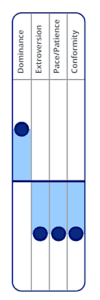
Let’s explore DOMINANCE– one of the 4 Cornerstone Behavioral Traits
FYNS precisely measures four cornerstone behavioral traits, Dominance, Extroversion, Pace/Patience, and Conformity. These are the DNA of your individual strengths, and combine to form your Basic/Natural Self, that is, how you function when there is freedom to respond in a completely natural way.
Our goal is that you learn to know and operate out of your natural self, understand how you most naturally relate to others, work, approach life, and gain the confidence to live from your natural strengths. We believe this will result in better relationships, effectiveness and efficiency in your work, and greater satisfaction and fulfillment in your life!
To see your unique pinpoint accuracy description for each of the four cornerstone behavioral traits, please refer to your personal “My Strengths Report.” However, over the next four blog posts, we want to take time to explain each of the four traits in greater detail. We will do this by elaborating on a key description of each trait. First, Dominance, your “Take-Charge Trait.”
HIGH DOMINANCE

Dominance, referred to as the “Take-Charge Trait,” gives us precise insight into how a person functions relevant to being: competitive, controlling, authoritative, to the point, a risk taker, and decisive to name a few.
Each of us have varying degrees and intensity of Dominance. For example, two team members may be on opposite ends of the dominance spectrum. One high and one low. You might be on the high end of the dominance spectrum described as taking charge to accomplish results, whereas your teammate may be on the low end of the dominance spectrum described as supportive and collaborative to accomplish results.
The high Dominance person is highly competitive, controlling and authoritative, to the point, a risk taker, and decisive. They want direct answers, challenge the status quo, expect to have authority and power, and cut to the chase requiring bottom line results. They don’t want external controls and trivial interferences.
When speaking to us they are authoritative, take-charge, comfortable being confrontational, and tell it like it is.
When listening they need concise and direct messages. They like hearing innovative, problem-solution approaches. Prefer hearing the big picture vs. all the detail.
© 1984, Rev. 2017 PDP, Inc. USA. All rights reserved.
LOW DOMINANCE
On the opposite end of the spectrum, like your teammate we just talked about, the strengths of your teammate’s low Dominance might be described as:
- Support others and collaborate to accomplish results
- Prefer not to impose demands upon others’ time and work
- Accommodating and helpful
- Mild mannered, composed, often modest
- May wait for others to take the lead
- Most productive in a non-confrontational, peaceful environment
- May react to offensive commands by withdrawing or delaying action
Remember, the higher your dominance, the more take-charge you will be, the lower the dominance the more supportive you will be. Example, you may be a highly dominant or like a hammer, however, not everything is a nail in the journey. It takes a combination of different people with different strengths to realize true success and fulfillment in life! The world would be a boring place if we were all wired the same.
© 1984, Rev. 2017 PDP, Inc. USA. All rights reserved.





